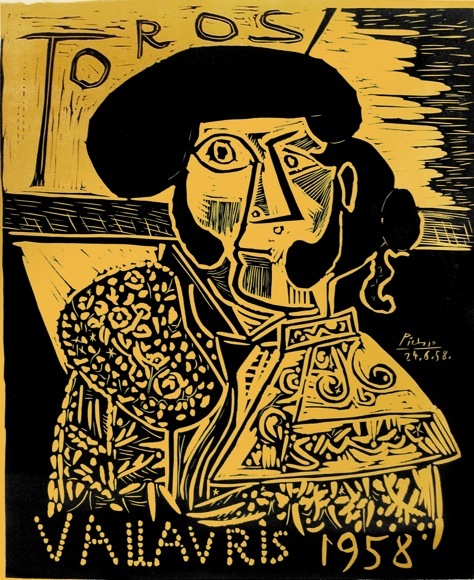TEL: 415.441.8680




Copyright © 2003-2013 | SITE MAP
December 5, 2009 - January 3, 2010

1958
Pablo Picasso,
Toros Vallauris 1958,
Print, Linocut in black and pale orange, Plate: 25 1/2 x 20 3/4 in.
Ed. 51/195 signed in red pencil





SIX CENTURIES OF PRINTMAKING
PART 2: 1800s to present
6 of 18
Pablo Picasso (Spain, Malaga, 1881 - 1973)
"Since the days of ancient Rome, the Riviera town Vallauris, near Cannes in the south of France, has been known for its fine clay and pottery. In 1946, Picasso attended an exhibition of pottery making in Vallauris. After observing their potters at work, Picasso sat at a borrowed bench, and enthusiastically created his first three ceramic figures. The infinite creative possibilities of ceramics that combined drawing, painting and sculpture so excited Picasso that he returned the next summer with sketches for new pieces, the first of many he was to create over the next 27 years".
In 1948 Picasso came to live in Vallauris, where he stayed until 1955. During his time in the town, he created a great many sculptures and paintings. He also developed a fascination for the two techniques of ceramics and linocuts. Many inhabitants still evoke his presence and that of his contemporaries (Françoise Gilot and her children Claude and Paloma, then Jacqueline Roque, his last partner whom he married amid the greatest secrecy at Vallauris town hall in 1961), the bullfights, exhibitions and visits by all kinds of famous people.
The bullfight figured prominently in Pablo Picasso's life; the energy and pageantry probably kept the artist coming back. Upon attending an event, he once remarked to a friend, "It's so rare to find an art that is so intelligent about itself" (Richardson, 242).
Picasso's linocuts were made by gouging out a sheet of linoleum which had been fused onto a harder block of wood. (Linoleum, softer and lighter than wood, allowed Picasso to work more quickly than would have been possible by working from woodblocks alone.) Using gouges, he would cut out the areas of his intended image that were to be absent of color (and therefore appear the color of the paper when printed). The relief areas that remain would be inked, usually with a brayer. Paper would be put on the inked linoleum block and pressure applied, after which the inked image is transferred to the paper. If there were to be multiple colors, Picasso would create a separate linoleum block, each corresponding to a different color, each printed in succession.
Besides the Toros series, Picasso designed one Exposition Vallauris poster each year from 1951 to 1964. The Arnéra studio in Vallauris is believed to have done all printing for this edition. A 1958 edition of the linocut shown inhere is in the permanent collection of the Los Angeles County Museum of Art (LACMA).


SOLD


